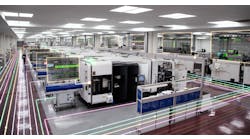Manufacturers are no strangers to automation. Since the first steam-powered machines, the manufacturing industry has focused on providing better products – and particularly through automating processes, lowering operating costs, and boosting quality for more than 50 years.
Just as with automation, manufacturers now are leading the way in applying Artificial Intelligence technology, applying AI-powered analytics to data to improve efficiency, product quality, and employees’ safety.
Recently Deloitte reported in a survey on AI adoption in manufacturing revealing that 93 percent of companies believe AI will be a crucial technology to drive growth and innovation. But, as the industry expands its use of AI, it also faces growing challenges of shorter time-to-market deadlines, increasingly complex products, and strict quality regulations and standards.
However, the vast majority of manufacturing companies have to overcome several other barriers that impede digital transformation and AI initiatives:
1. Shortage of AI talent. Organizations across all industries are discovering that experienced data scientists and AI professionals are scarce and difficult to hire. AI projects require an interdisciplinary team of data scientists, ML engineers, software architects, and BI analysts and SMEs. Many businesses do not have and cannot afford to deploy these resources for a single data-science project. And, when you have multiple data-science projects to execute, it becomes even more difficult to scale to deliver on time.
This issue is particularly evident in manufacturing, a market sector that many young data scientists consider to be monotonous, repetitive, and unstimulating. Compounding this issue, manufacturing is expected to face a severe workforce shortage over the next 10 years as Baby Boomers retire. AI Automation and AutoML 2.0 are critical technologies that can address this Skills Gap and accelerate digital transformation in manufacturing.
2. Technology infrastructure and interoperability. Manufacturing sites often have a wide variety of machines, tools, and production systems that use different and sometimes competing technologies, some of which may be running on outdated software that is not compatible with the rest of their system. In the absence of standards and common frameworks, plant engineers must determine the best way to connect their machines and systems, and which sensors or convertors to install.
An ecosystem that offers compatible components that use standard rules and frameworks to connect to ERP, MES, and PLC/SCADA systems will address issues with interoperability. OPA UA is becoming the essential protocol for Industry 4.0 communication and data modeling.
3. Data quality. Access to clean, meaningful, high-quality data is critical for the success of AI initiatives, but can be a challenge in manufacturing. Manufacturing data often is biased, outdated, and full of errors, which can be caused by multiple factors. One example is sensor data collected on the production floor in extreme, harsh operating conditions, where extreme temperature, noise and vibration variables can produce inaccurate data. Plants have historically been built using many proprietary systems, which do not talk to one another, where operational data also may be spread across multiple databases in multiple formats not suitable for analytics, requiring extensive preprocessing.
For example, a predictive maintenance application will need access to the computerized maintenance management system or process historians. It also may require connectors or custom scripts to retrieve and manipulate the data.
To address these issues, organizations can deploy an AutoML 2.0 solution that automates AI- focused data ingestion and preparation. This frees BI teams from the cumbersome processes needed to unify data stored in different sources to utilize in AI/ML projects.
4. Real-time decision-making. This is becoming increasingly important in manufacturing applications, such as monitoring quality, meeting customer delivery dates, and more. Often, decisions need to be acted upon immediately -- within seconds, or sometimes milliseconds -- to identify a problem before it results in unplanned outages, a manufacturing defect, or a safety issue. Such rapid decision-making requires streaming analytics capability and real-time prediction services that enable manufacturers to act immediately and prevent undesirable consequences.
5. Edge deployments. There are many potential use cases of edge computing in the manufacturing industry. Edge computing allows manufacturers to process data locally, filter data and reduce the amount of data sent to a central server, either on site or in a cloud. Additionally, a key goal in modern manufacturing is to be able to use data from multiple machines, processes and systems to adapt the manufacturing process in real-time. This precision monitoring and control of manufacturing assets and processes uses large amounts of data and needs machine learning to determine the best action as a result of the insight from the data, and also requires edge-based computing. The ability to deploy predictive models on the edge devices such as machines, local gateway, or server is critical to enable smart manufacturing applications.
6. Trust and transparency. A significant barrier to broad AI adoption is the complexity of the technology and manufacturers’ lack of trust in its capabilities. People without a data science background struggle to understand how data science and predictive modeling works, and do not have confidence in the abstract algorithms behind AI technology. Greater transparency would provide information about the AI process -- the input data used, what algorithms were selected, and how the model made its predictions.
While most AI traditionally uses ‘black box’ models, new approaches to data science provide more transparency into the full AI pipeline. This includes insight into the detailed process to transform the raw data into the inputs of machine learning (a.k.a. feature engineering) and how the ML model produces predictions by combining hundreds of or even more features. By giving insight about how the prediction models work and the reasoning behind predictions, manufacturing organizations can build greater trust in the models and resulting business insights produced.
While challenges to AI adoption still exist, empowering manufacturing and production SMEs to do more with less using AI automation is the right way to accelerate manufacturing digital transformation. AI automation is helping manufacturing companies reduce costs, improve efficiency and solve new problems.
Central to a successful AI program is deploying a data-science automation platform that can integrate seamlessly with your current systems and solutions, and can automate the full data science life-cycle, freeing SMEs to focus on the results of your AI and machine learning applications, not the headaches of the data science process.
Ryohei Fujimaki is the founder and CEO of dotData, a spin-off of NEC Corporation and the first company focused on delivering full-cycle data science automation for the enterprise.






